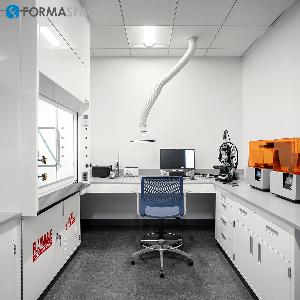
Clinical 2.0 to Increase Value & Profitability of Clinical Pathology Labs
Could Clinical 2.0 help clinical pathology labs fight back in the funding wars?
AUSTIN, TEXAS, USA, October 7, 2019 /EINPresswire.com/ -- Over the last few decades, clinical labs serving the healthcare industry have made great strides in reducing TAT (turn-around-time, e.g. wait time for results), providing more innovative, clinically useful tests, integrating tests into the EHR information stream, and most importantly, providing more accurate, more standardized, and more repeatable test resultsThe last bullet item above is the most critical. As labs have striven to provide more accurate (and repeatable) results, those paying for the tests (e.g. the federal CMS, insurance companies, hospital administrators, etc.) have taken notice.
But, rather than congratulating laboratories for their efforts, they have interpreted this progress as evidence that labs tests, taken as a whole, have become a commodity item — a commodity that can be bid out to the lowest bidder.
Acting under the auspices of PAMA (the Protecting Access to Medicare Act), the CMS made deep cuts (as much as 30% percent) on Jan 1, 2018 to the Clinical Laboratory Fee Schedule (CLFS), which sets the all-important reimbursement amounts paid to clinical pathology laboratories by the government.
Because insurance companies also use CMS rates as guidance for their own non-CMS reimbursement rates, the effect of these cuts was widespread — despite bitter opposition from groups, such as the AMA, who argued that the process for determining reimbursement rates was inherently flawed.
Nonetheless, given the ongoing trend toward falling reimbursement rates (the CMS intends to set new reimbursement rates again in 2021 that are expected to be even lower), quite a few hospital administrators are considering their options before reimbursements go any lower, including spinning off their internal clinical laboratory operations as separate businesses, or selling their lab operations outright to private lab companies, and taking the money to fill shortfall gaps in their own hospital budgets.
Reducing reimbursement rates is part of the effort to reduce healthcare costs in the US, which despite spending far and away the most of any country (up to 17.8% of US GDP went to healthcare spending in 2016, according to a JAMA published study), continues to lag behind most developed countries when it comes to patient healthcare outcomes and life expectancy.
Many in Congress believe the solution is to move from an FFS (Fee for Service) payment model (e.g. one where medical providers, including clinical labs, are paid for each service — or test in the case of a clinical lab) toward a new value-based model, known as VBP (Value-Based Pricing).
Simply put, the VBP approach seeks to change up the healthcare industry by providing financial rewards for better patient outcomes. In other words, if a population of patients shows improvement, the government will provide greater funding to those medical groups, using the carrot of bonus payments as a reward and the stick of penalties for those who fail to meet minimum standards.
Clinical labs, which have been doing an outstanding job within their testing “silos,” are frankly not that well placed in the healthcare ‘budget wars.’ And the existing business model of most clinical laboratories is about as FFS (fee for service) as you can get.
Something has to change.
The crux of the problem is that in the eyes of healthcare payers, both pre-clinical lab activities (such as a doctor deciding which tests are needed) and the post-clinical test decisions (again, also performed by doctors who choose a course of action based on clinical lab tests results) are of greater “value” than the activities of clinical labs – despite the fact that these very test results inform decisions made by physicians!
What can be done about this?
Clinical and pathology lab leaders have come together to address this issue — under the banner of Clinical 2.0.
So what is Clinical 2.0?
First, it’s an effort to understand the nature of the structural challenges facing clinical pathology labs today.
Second, it’s an advocacy group calling for clinical pathology labs to change their business model in order to thrive in a VBP world.
Formaspace built the laboratory facilities for one of the world’s largest diagnostic laboratories, the Department of Defense’s FADL (Food & Drug Diagnostics Lab) at Ft Sam Houston, in San Antonio, Texas.
The key recommendations of Clinical 2.0 are:
Become more central to the decision-making process by making partnerships within organizations, increasing your lab’s visibility (and perceived value) to executives, and, most importantly, having a seat at the budgeting table.
Implement the use of longitudinal patient records (which capture all test procedures in each patient’s history in a single place) to keep track of individual patient tests (rather than just providing spot lab tests with no context).
Leverage longitudinal patient records to monitor each individual patient’s healthcare, and provide proactive services, such as recommending tests on a timely basis, as well as providing evidence-based contexts for post-test treatment plans.
To this, we would like to add another recommendation if we could. Clinical Pathology Labs could take these recommendations one step further and strive toward becoming the gatekeepers of AI systems that will be performing more and more test interpretation work in the future.
Given the highly disciplined and analytical nature of this work, we believe clinical pathology labs are well suited to this task.
Read more ... https://formaspace.com/articles/sample-processing/clinical-2-and-clinical-pathology-laboratories/?utm_source=einpresswire&utm_medium=content&utm_campaign=article-100119
Mehmet Atesoglu
Formaspace
+5122792792
email us here
Keynote Presentation: Clinical Lab 2.0 - How Laboratories Can Thrive in a Value Based Care System
EIN Presswire does not exercise editorial control over third-party content provided, uploaded, published, or distributed by users of EIN Presswire. We are a distributor, not a publisher, of 3rd party content. Such content may contain the views, opinions, statements, offers, and other material of the respective users, suppliers, participants, or authors.





